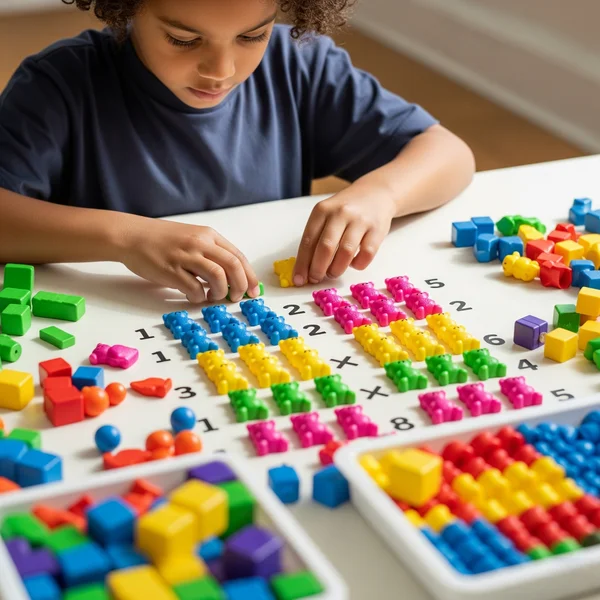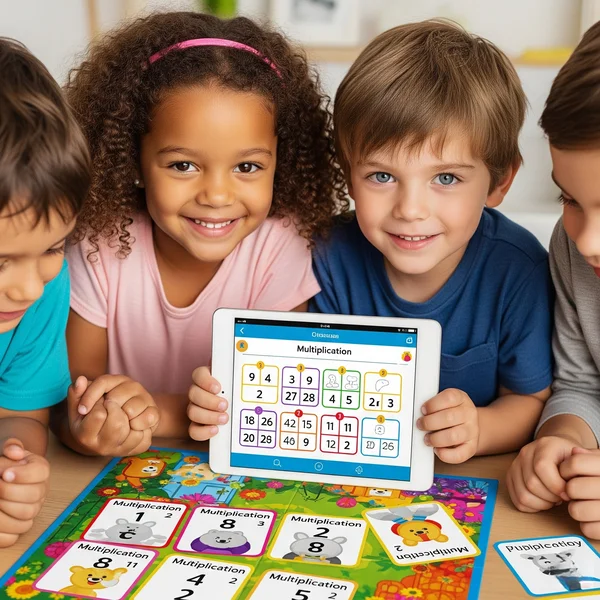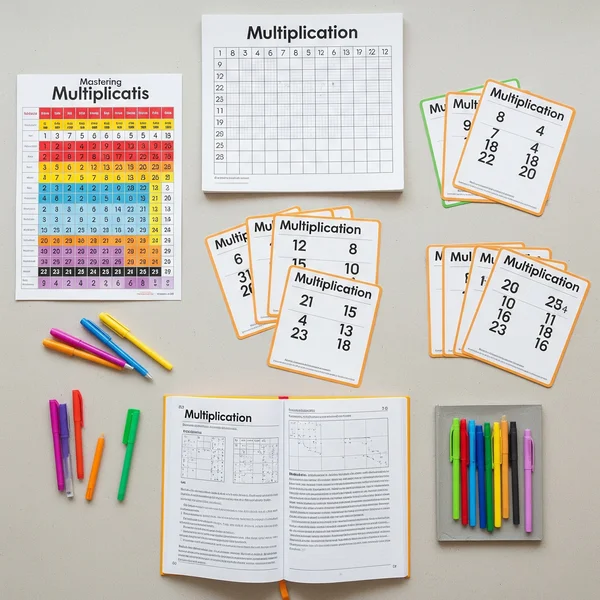곱셈에 어려움을 겪는 학생들을 위한 지침: 학부모 가이드
자녀의 곱셈 어려움 극복 돕기: 실용적인 조언
자녀가 곱셈에 어려움을 겪는 것을 지켜보는 것은 힘들 수 있습니다. 도와주고 싶지만, 곱셈에 어려움을 겪는 자녀에게 어떻게 효과적으로 가르칠까요? 더 큰 좌절감을 주지 않고 말이죠. 자녀가 구구단 암기나 개념 이해에 어려움을 느낀다면 혼자가 아닙니다. 이 학부모를 위한 곱셈 가이드 는 실용적인 곱셈 전략 과 따뜻한 조언을 제공하도록 설계되었습니다. 특히 수학 학습에 어려움을 겪는 아이들 이 자주 마주치는 수학적 어려움 을 극복하고 곱셈을 더 쉽고 즐겁게 만들 수 있는 방법을 알아보겠습니다. 함께 지원적인 학습 방법을 찾아봅시다.

자녀가 곱셈에 어려움을 겪는 이유 이해하기
해결책을 찾기 전에, 특히 학습에 어려움을 겪는 학생 들이 곱셈을 어려워하는 몇 가지 일반적인 이유를 이해하는 것이 도움이 됩니다.
기초적인 수 감각의 부족
곱셈은 이전 수학 기술을 기반으로 합니다. 자녀가 덧셈, 건너뛰어 세기 또는 기본적인 수 감각 을 확실히 이해하지 못하면, "묶음" (곱셈의 핵심)을 이해하기 어려울 수 있습니다. 이러한 기초 기술 은 매우 중요합니다.
기억력 및 회상력 문제
구구단을 암기하려면 상당한 기억력이 필요합니다. 어떤 아이들은 다른 아이들보다 암기를 어려워하는 경향이 있어, 사실을 빠르게 떠올리는 데 어려움을 겪을 수 있습니다. 아이가 구구단을 암기하지 못하면 어떻게 해야 할까요? 이것은 흔한 고민입니다.
수학 불안감과 자신감 부족
과거의 부정적인 경험이나 압박감은 수학 불안감 을 유발할 수 있습니다. 자녀가 불안하면 작업 기억력이 저하되어 정보를 배우고 기억하는 것이 더 어려워집니다. 자신감 부족은 자기 충족적인 예언을 만들어낼 수도 있습니다.
현재의 교육 방법과의 불일치
모든 아이들은 고유한 학습 스타일 을 가지고 있습니다. 한 아이에게 효과적인 교육 방법이 다른 아이에게는 효과적이지 않을 수 있습니다. 학생은 주로 제공되는 것보다 더 시각적이거나, 실제적인 또는 청각적인 접근 방식이 필요할 수 있습니다.
이러한 잠재적인 근본적인 문제를 인식하면 곱셈에 어려움을 겪는 학생들을 가르치는 데 있어 지원을 더 효과적으로 맞춤화하는 데 도움이 될 수 있습니다.
기초 단계: 구구단에 들어가기 전에
특히 곱셈에서 아이들이 수학을 성공적으로 배우도록 돕기 위해서는 다음과 같은 전제 조건을 확실히 이해해야 합니다.
반복 덧셈 마스터하기
자녀가 곱셈이 본질적으로 반복 덧셈의 지름길이라는 것을 이해하도록 합니다(예: 3 x 4는 4 + 4 + 4와 같습니다). 물건을 사용하여 이를 보여주세요.
건너뛰어 세기의 중요성
(2씩, 5씩, 10씩, 그리고 3씩, 4씩 등) 자신감 있게 건너뛰어 세기를 할 수 있으면 곱셈 패턴을 이해하고 사실을 기억하는 데 튼튼한 기반이 됩니다.
"묶음"에 대한 구체적인 이해 구축하기
일상적인 물건을 사용하여 "묶음"의 개념을 설명합니다. 예를 들어, "사과 4개씩 3묶음이 있습니다. 총 사과는 몇 개입니까?" 이러한 실습적인 접근 방식은 곱셈의 의미를 확고히 하는 데 도움이 됩니다.
학습에 어려움을 겪는 학생들을 위한 효과적인 곱셈 전략
수학적 어려움을 겪는 아이를 돕는 가장 좋은 방법 은 하나로 정의할 수 없습니다. 다양한 곱셈 전략 을 시도해 보세요.

조작물(블록, 계산 도구) 사용하기
레고 블록, 계산용 곰돌이 또는 말린 콩과 같은 수학용 조작물 은 곱셈을 구체적으로 만들 수 있습니다. 자녀가 곱셈 사실을 나타내는 배열(예: 4개의 블록을 3줄로)을 만들도록 하세요.
시각적인 접근 방식: 배열과 면적 모델
배열(행과 열에 점) 또는 면적 모델(부분으로 나뉜 직사각형)을 그리면 아이들이 곱셈을 시각적으로 이해하는 데 도움이 될 수 있습니다. 이것은 훌륭한 수학 시각 보조 도구 입니다.
스토리텔링과 실생활 맥락
곱셈 사실을 중심으로 간단한 이야기를 만들어 보세요. "3명의 해적이 각각 금화 6개를 발견했다면, 총 금화는 몇 개입니까?" 수학을 관련성 있는 시나리오와 연결하면 더욱 흥미로워집니다.
사실 분할(예: 7의 경우 5+2 트릭)
더 어려운 사실을 더 쉬운 사실로 분할하는 전략을 가르치세요. 예를 들어, 7 x 6을 풀려면 (5 x 6) + (2 x 6) = 30 + 12 = 42를 할 수 있습니다. 이렇게 하면 어려운 구구단이 덜 어렵게 느껴집니다.
유용한 곱셈표 활용하기
명확한 곱셈표는 귀중한 도구가 될 수 있습니다. 이를 사용하여 자녀가 패턴을 보고, 답을 확인하고, 사실에 대한 친숙함을 키우도록 도와주세요. "부정행위"가 아닌 지원적인 발판으로 생각하세요.
곱셈 연습을 긍정적이고 즐겁게 만들기
곱셈을 학습에 어려움을 겪는 학생들에게 어떻게 재미있게 만들까요? 연습에 대한 접근 방식이 중요합니다.

짧고, 빈번하며, 다양한 연습 시간
학습에 어려움을 겪는 학생들을 위해 매일 얼마나 연습해야 할까요? 길고 압도적인 연습 시간보다는 짧고(10-15분), 규칙적인 연습 시간을 목표로 하세요. 흥미를 유지하기 위해 활동을 다양하게 하세요 – 어떤 날은 플래시 카드, 다음 날은 게임.
곱셈 게임 및 앱 활용하기
곱셈 사실 연습을 재미있고 상호 작용적으로 만드는 많은 어린이용 수학 게임 및 교육 앱이 있습니다. 이것은 연습에 대한 저항을 크게 줄일 수 있습니다.
속도가 아닌 노력과 진행 상황에 초점 맞추기
정답을 빠르게 맞히는 것뿐만 아니라 자녀의 노력과 끈기를 칭찬하세요. 작은 발전을 축하하여 자신감을 키워주세요. 이것은 긍정적 강화 의 핵심입니다.
압박감 없는 학습 환경 조성하기
연습을 시험이나 힘든 일처럼 느끼게 하지 마세요. 분위기를 가볍고, 지원적이며, 격려적으로 유지하세요. 이것은 학부모 지원 교육 에 중요합니다.
자원 활용하기: 아이들이 수학을 배우도록 돕는 도구
직접적인 교육 외에도 사용 가능한 교육 자료 를 활용하세요.

인쇄 가능한 구구단 및 빈 격자
참고용으로 채워진 구구단과 활동적인 회상 연습을 위한 빈 격자를 사용하세요. 온라인에서 훌륭한 인쇄 가능한 곱셈 자료를 찾을 수 있습니다.
대화형 온라인 학습 플랫폼
많은 웹사이트에서 곱셈에 대한 대화형 수업, 게임 및 퀴즈를 제공합니다. 자녀에게 어떤 것이 공감되는지 몇 가지 살펴보세요.
곱셈용 교육 앱
게임화를 통해 곱셈 학습을 매력적으로 만드는 많은 앱이 있습니다.
워크북 및 활동지
특히 다양한 문제 유형과 명확한 설명을 제공하는 경우 전통적인 워크북이 여전히 유용할 수 있습니다. 숙제 도움 및 체계적인 연습을 위해 사용하세요.
아이들의 수학적 어려움에 대한 추가 도움을 요청해야 하는 시기
언제 자녀의 수학 실력을 걱정해야 할까요? 학부모의 지원이 중요하지만, 때로는 더 전문적인 도움이 필요할 수 있습니다.
노력에도 불구하고 지속적인 진전 부족
꾸준한 노력과 다양한 전략을 시도한 후에도 자녀가 여전히 진전을 보이지 않으면 다른 선택을 모색해야 할 때일 수 있습니다.
수학에 대한 심각한 정서적 고통
곱셈이 극심한 불안, 눈물 또는 지속적인 거부감을 유발하는 경우 정서적 측면을 해결하는 것이 중요합니다.
먼저 자녀 담임 선생님과 상담하기
자녀의 담임 선생님은 귀중한 파트너입니다. 걱정되는 점을 선생님과 상의하세요. 선생님은 추가적인 통찰력이나 전략을 가지고 있거나 학교 내 지원을 제안할 수 있습니다.
전문적인 과외 또는 교육 지원 고려하기
자격을 갖춘 과외 선생님이나 교육 치료사는 자녀의 필요에 맞춘 일대일 관심과 특수한 기술을 제공할 수 있습니다. 이러한 과외 팁 은 매우 귀중할 수 있습니다.
곱셈에서 자녀가 성공하도록 도울 수 있습니다!
학습에 어려움을 겪는 학생들에게 곱셈을 가르치는 것은 인내심, 창의력 및 긍정적인 태도가 필요합니다. 모든 아이는 자신의 속도로 학습한다는 것을 기억하세요. 그들의 어려움을 이해하고, 효과적인 곱셈 전략 을 사용하고, 지원적인 학습 환경을 조성함으로써 아이들이 수학을 배우고 자신감을 키우도록 도울 수 있습니다. 당신은 그들의 가장 큰 후원자입니다! 우리 플랫폼에서 수학 학습을 지원하는 더 많은 방법을 알아보세요.
학습 장애가 있는 학생들에게 곱셈을 가르치는 것에 대한 질문에 대한 답변!
자녀가 곱셈에 정말로 어려움을 겪고 있다는 첫 번째 징후는 무엇입니까?
곱셈에 어려움을 겪는 첫 번째 징후는 무엇입니까? 초기 징후에는 연습 후에도 기본적인 사실을 떠올리는 데 지속적인 어려움, 간단한 곱셈을 위해 손가락 계산에 크게 의존하는 것, 곱셈이 포함된 다단계 문제에서 빈번한 실수, 또는 곱셈 작업에 대한 상당한 좌절감이나 불안감을 표현하는 것이 포함될 수 있습니다.
자녀가 곱셈에 어려움을 겪는 경우 매일 얼마나 곱셈 연습을 해야 합니까?
학습에 어려움을 겪는 학생 의 경우 짧고, 긍정적이며, 꾸준한 연습 시간이 가장 좋습니다. 긴 시간의 연습보다 매일 또는 대부분의 날에 10-15분의 집중적인 연습을 목표로 하세요. 연습의 질이 양보다 중요합니다.
학습에 어려움을 겪는 학생들이 더 어려워하는 특정 구구단이 있습니까?
네, 6단, 7단, 8단, 9단(9단은 간단한 요령이 있지만)은 2단, 5단, 10단보다 패턴이 덜 명확하기 때문에 더 어렵다고 여겨집니다. 7단은 많은 사람들에게 악명 높게 어렵습니다.
자녀가 거부하는 경우 암기를 강요해야 합니까?
자녀가 거부하는 경우 암기를 강요하면 수학 불안감 이 증가하고 학습에 대한 부정적인 연관성이 생길 수 있습니다. 대신 왜 거부하는지 알아내려고 노력하세요. 학습을 재미있게 만들고, 다양한 곱셈 전략 을 사용하고, 먼저 이해를 구축한 다음 게임과 압박감 없는 활동을 통해 암기를 부드럽게 장려하는 데 집중하세요. 지원을 위한 곱셈표와 같은 자료를 사용하면 압박감을 줄일 수도 있습니다.